Welcome to Upright Forklift Repair, your go-toexpert for forklift service, repair and spare parts in Houston, TX, and Humble. In the world of material handling and warehousing, understanding the various types of forklifts available is crucial to optimizing your operations and ensuring safety in the workplace. Among the different forklift models, the reach truck forklift stands out for its unique capabilities and design, tailored for specific warehouse needs.
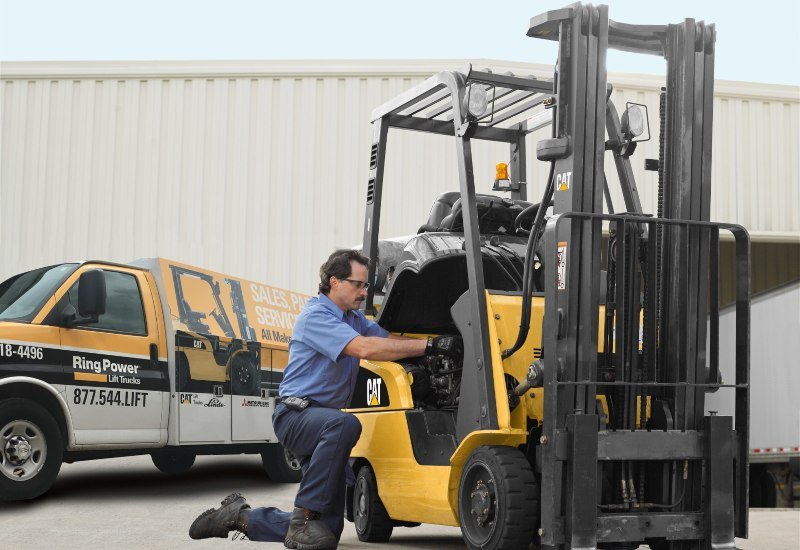
This guide is dedicated to unraveling the mysteries of the reach truck forklift, a pivotal piece of equipment in modern warehousing, to help you make informed decisions for your business. With our extensive experience and expertise, Upright Forklift Repair is here to guide you through the intricacies of reach truck forklifts, ensuring your operations run smoothly and efficiently.
Understanding Reach Truck Forklifts
The Basics of Reach Truck Forklifts
Reach truck forklifts are designed with precision for specific warehouse operations, particularly excelling in environments where space is at a premium. Unlike traditional counterbalance forklifts, reach trucks are built to operate in narrow aisles, thanks to their compact footprint and unique design that allows them to ‘reach’ into racking spaces.
The reach truck forklift is particularly notable for its operator position and standing configuration, which enhances maneuverability and visibility. Operators stand within the truck’s footprint, offering them an unobstructed view of the racking system and the load. This design not only improves operational efficiency but also significantly increases safety by reducing the risk of accidents and injuries associated with poor visibility. Reach trucks are an indispensable asset in warehouses and storage facilities that utilize high-density storage systems and narrow aisles, enabling businesses to maximize their storage capacity and streamline their operations.
Understanding Reach Truck Forklifts
The Basics of Reach Truck Forklifts
A reach truck forklift is a specialized material handling device engineered to work within the confines of narrow aisles, making it an ideal choice for warehouses and storage facilities where space optimization is key. Characterized by its ability to ‘reach’ into racking to pick or place loads, this equipment is distinguished from traditional forklifts by its unique design and functionality.
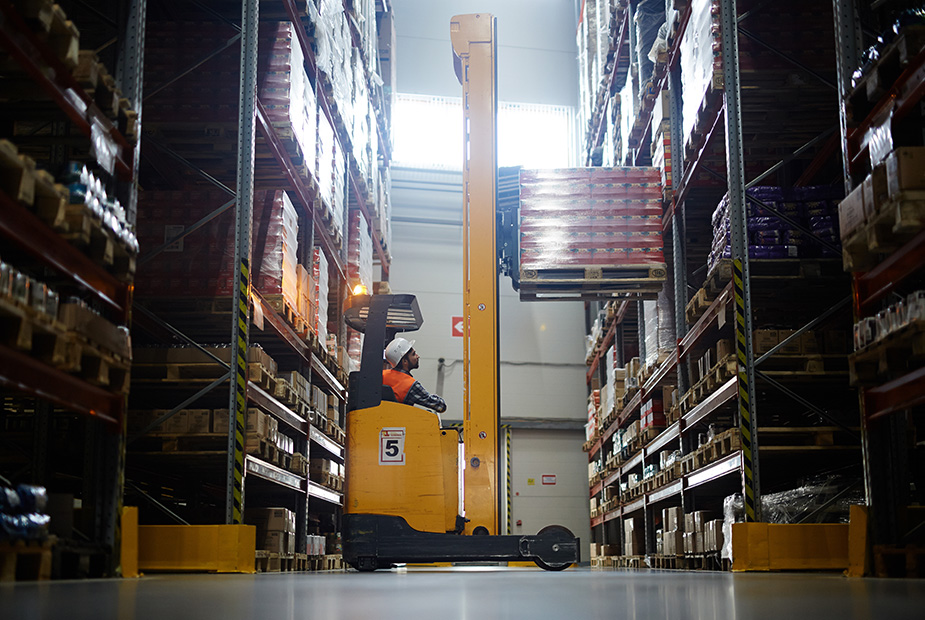
Reach trucks are typically stand up forklifts, where the operator controls the vehicle from a standing position, enhancing maneuverability and visibility within tight spaces. This design allows operators to efficiently navigate narrow aisles, reducing the aisle width required for operation compared to standard counterbalance forklifts. The compact footprint and agile performance of reach truck forklifts make them indispensable in modern warehousing, where maximizing storage density and operational efficiency are paramount.
How Reach Truck Forklifts Work?
The operational mechanics of reach truck forklifts revolve around a sophisticated design that includes a moving mast and reach mechanism. Unlike conventional forklifts, where the load is carried in front of the vehicle, reach trucks are equipped with a moving mast that can extend forwards and upwards, allowing the forks to reach into racking spaces. This feature, combined with the operator standing position, provides unparalleled agility and precision in handling loads.

The operator’s standing position not only ensures a compact vehicle profile but also offers an enhanced field of vision, crucial for safely navigating through narrow aisles and accurately positioning loads. This unique combination of features—moving mast, reach capability, and operator standing position—defines the core functionality of reach truck forklifts, enabling efficient and safe operations in environments where space is at a premium.
Benefits of Using Reach Truck Forklifts
Efficiency in Narrow Aisles
Reach truck forklifts are engineered to excel in narrow aisle applications, significantly increasing storage density within warehouses and storage facilities. By minimizing the aisle width required for operation, these vehicles allow for tighter racking arrangements, effectively maximizing the use of available space. This capability is particularly beneficial in high-density storage environments where every inch of floor space counts.

The ability to operate efficiently in narrow aisles, combined with the reach mechanism, enables operators to access high and deep storage locations, thereby enhancing the overall storage capacity of the facility. The design of reach trucks, focused on narrow aisle navigation and space optimization, directly contributes to increased productivity and operational efficiency, making them a vital component of modern warehousing solutions.
Enhanced Safety and Load Handling
Reach truck forklifts are engineered with safety and efficiency in mind, offering significant advantages in lift height and unit load handling. The ability to reach high elevations is a key feature, with some models capable of lifting loads to heights exceeding 30 feet. This capability ensures the optimal use of vertical space in warehouses, enhancing storage density and efficiency.
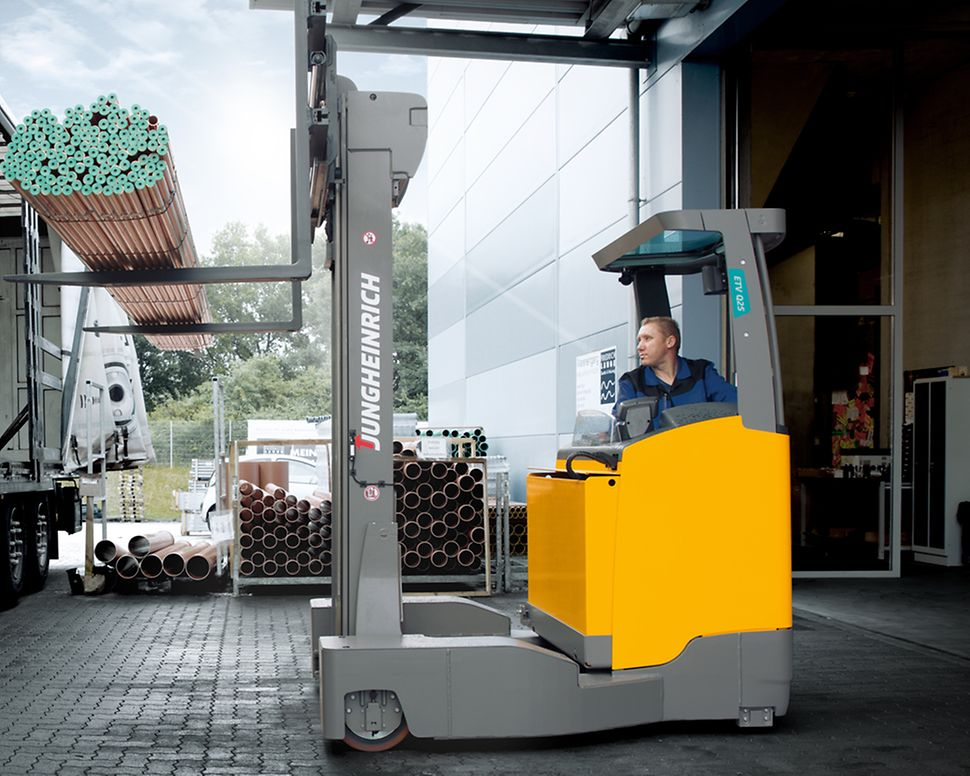
Additionally, reach trucks are designed for precise unit load handling, allowing operators to smoothly and safely place or retrieve pallets from tight spaces. The combination of high lift heights and accurate load handling significantly reduces the risk of accidents and damage to goods, ensuring a safe working environment and improved operational performance.
Types of Reach Truck Forklifts
Stand-Up Forklifts vs. Sit-Down Forklifts
When comparing stand-up forklifts to sit-down forklifts, the key difference lies in the operator’s position and the forklift’s intended use. Stand-up forklifts, often synonymous with reach trucks, allow operators to quickly mount and dismount, making them ideal for tasks requiring frequent on and off operations, such as in high-paced warehousing environments. This design prioritizes maneuverability and visibility, as operators have a clear view of the warehouse aisles and racking systems without the constraints of a seated position.

Sit-down forklifts, on the other hand, provide comfort and stability for operations requiring less frequent dismounting, suitable for longer hauls within a facility. The choice between the two depends on the specific needs of the warehouse operations, including the layout, the frequency of load handling tasks, and the operator’s comfort and efficiency.
Telescopic vs. Moving Mast Reach Trucks
Telescopic forklift trucks and moving mast reach trucks offer distinct features for handling loads in various warehouse settings. Telescopic forklifts, also known as telehandlers, feature a boom that extends and retracts, allowing them to reach further and higher with loads than traditional forklifts.
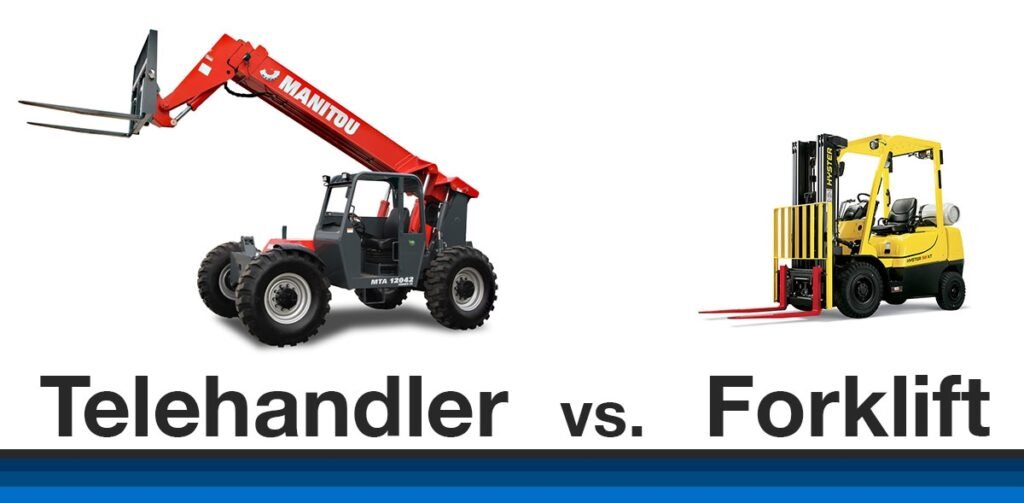
This capability is especially beneficial for outdoor applications or construction sites where distance and terrain variability play significant roles. Moving mast reach trucks, conversely, are designed with a mast that moves forwards and upwards, enabling precise and efficient load handling in narrow aisle warehouses. The mast’s forward movement allows the truck to reach into racking to pick or place loads without needing to extend the forks too far, which enhances stability and safety.
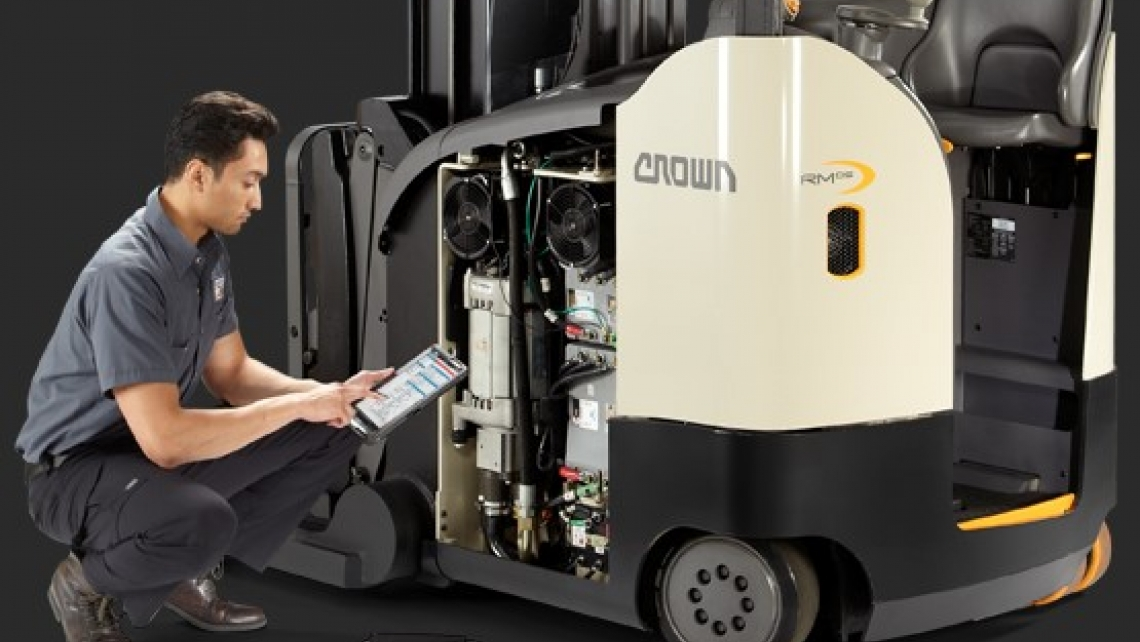
Both types are invaluable for their specific applications, with telescopic trucks offering versatility and reach in open spaces and moving mast trucks providing efficiency and precision in confined warehouse environments.
How to Operate a Reach Truck Forklift
Basic Operation Guidelines
Operating a reach truck forklift requires understanding its unique controls and functionalities. Here’s a simplified step-by-step guide to get you started:
Preparation:
Before starting, ensure you’re wearing the appropriate safety gear. Conduct a pre-operational check to verify the reach truck is in good working condition.
Positioning:
Stand in the operator compartment, firmly planting your feet. Grasp the controls comfortably, keeping an eye on your surroundings.
Moving:
To move the forklift, use the directional controls. Start slowly, gaining a feel for the truck’s response.
Forks Forward:
To extend the forks, use the reach control. This allows the forks to move forward into the racking without moving the truck itself.
Lifting and Lowering Loads:
Utilize the lift controls to raise or lower the forks to the desired height. Ensure the load is secure before moving.
Retracting:
Once the load is securely placed or retrieved, retract the forks back into their starting position.
Returning:
Carefully navigate the reach truck back to the starting point or to the next task.
Always remember, safety and precision are paramount when operating a reach truck forklift.
Reach Truck Training and Safety
Proper training is essential for operating a reach truck forklift safely and efficiently. Reach truck training programs cover operational techniques, safety protocols, and emergency procedures, ensuring operators are well-equipped to handle the equipment. Training emphasizes the importance of maintaining stability, especially when handling loads at high lift heights or when navigating narrow aisles.
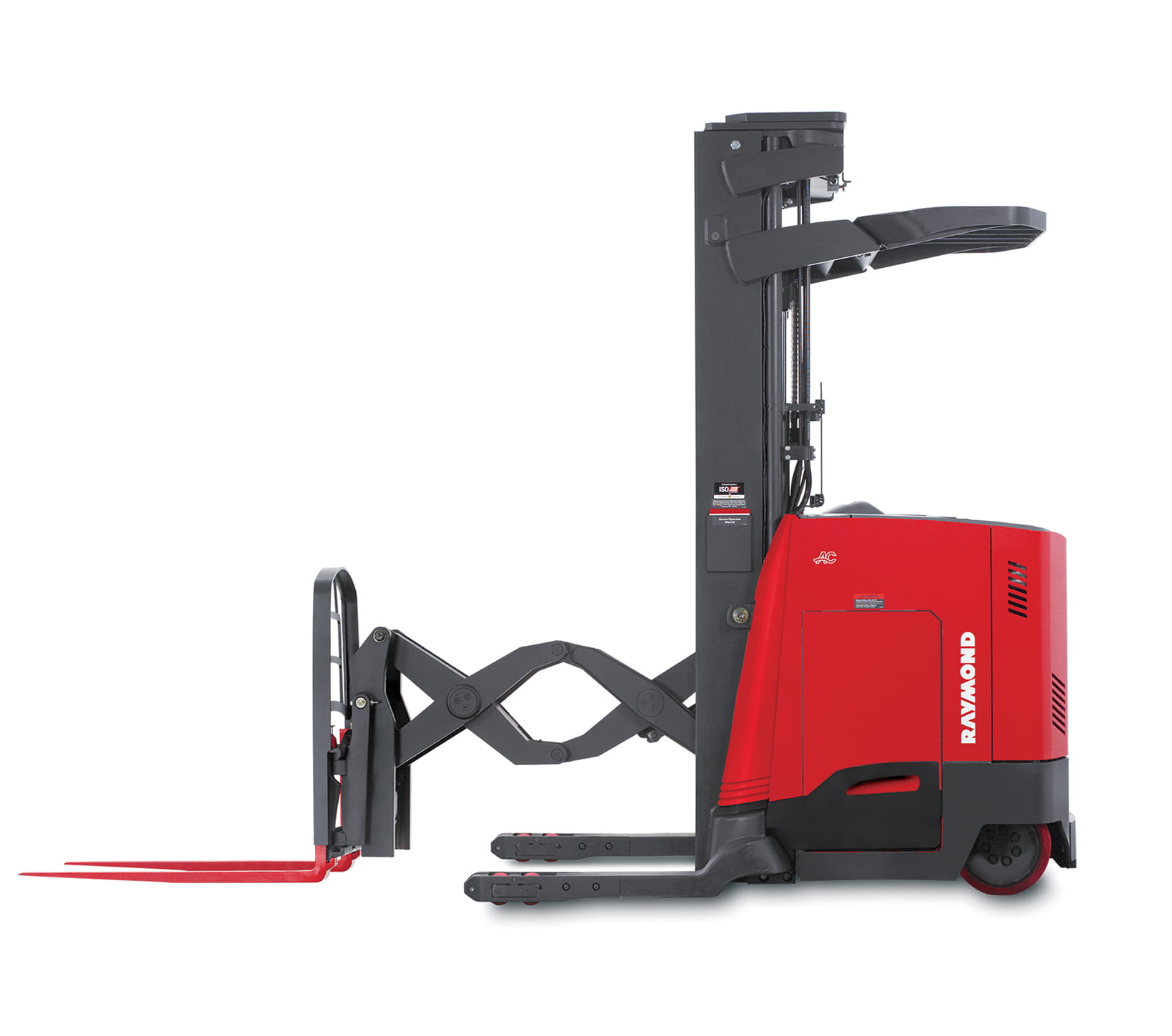
Operators learn to assess the weight and distribution of loads, adjust speeds appropriately, and execute maneuvers without compromising the forklift’s stability or safety. Regular refresher courses are recommended to keep skills sharp and updated with the latest safety standards. Remember, a well-trained operator is the key to maintaining a safe and productive work environment.
The Versatility of Reach Truck Forklifts in Warehouse Operations
Maximizing Efficiency in Narrow Aisles
Reach truck forklifts are a game-changer for warehouses requiring efficient space management and high-density storage. Designed to operate in narrow aisles, these lift trucks are pivotal in maximizing storage density without compromising the ability to quickly retrieve and place pallets. The stand-up configuration, coupled with the moving mast reach truck’s ability to extend its forks forward, allows operators to maneuver in tight spaces with precision.
This adaptability is enhanced by the reach truck’s lift height capabilities, enabling unit load handling at various elevations, thus optimizing pallet positions within the racks. The operator stands within the truck, benefiting from an optimal operator position that ensures stability and safety, even when navigating narrow spaces or handling heavier loads. Reach truck training further empowers operators to utilize these vehicles’ full potential, ensuring productivity and efficiency in modern warehouses. These forklift trucks, with their unique two outer legs design, offer unparalleled maneuverability and are an essential tool for warehouses aiming to enhance their operational efficiency and storage capacity.
